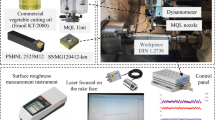Abstract
Tool changing is on the basis of tool wear failure and breakage failure. Utilization rate of the tool is low, which cannot guarantee the reliability of the whole machining system. In machining process, as the number of parts produced increases, tool wear is constantly increasing, which will contribute to the reduction of the reliability of the cutting tool. That account for processing of substandard products. Combining the moment estimation with the maximum likelihood estimation with the dynamic reliability analysis method, the study builds a mathematical model of the dynamic reliability for machining process under the premise of regarding cutting parameters as random variables. The reliability of overall machining process is lower than a given target; the proposed model can identify the tool which has the biggest failure rate quickly and accurately. The failure rate formula of each tool involved in each operation is deduced as well. Based on failure rate, an algorithm for defining the critical tool and its corresponding tool change time is proposed. Beyond that, for maximizing the utilization of every tool, the given model can pick up the cutting parameter which has the largest sensitive degree to the reliability via sensitivity analysis method. Then, the selection of relevant stock removal should be changed so as to improve the reliability of cutting tool and the whole process system, as well as enabling the cutter continue to work and delaying tool change time finally. Ultimately, the manufacturing process can maximize the cutters’ potential and thus reduce the number of tool changes, as well as the production costs.
Similar content being viewed by others
Change history
25 June 2021
A Correction to this paper has been published: https://doi.org/10.1007/s00170-021-07435-2
References
Ramalingam S, Watson JD (1977) Tool-life distributions—part 1: single-injury tool life model. J Eng Ind Trans ASME 99(3):519–522
Wang KS, Lin WS, Hsu FS (2001) A new approach for determining the reliability of a cutting tool. Int J Adv Manuf Technol 17:705–709
Akturk MS, Ghosh JB, Gunes ED (2004) Scheduling with tool changes to minimize total completion time: basic results and SPT performance. Eur J Oper Res 157(3):784–790
Akturk MS, Ghosh JB, Kayan RK (2007) Scheduling with tool changes to minimize total completion time under controllable machining conditions. Comput Oper Res 34(7):2130–2146
Oral A, Cakir MC (2004) Automated cutting tool selection and cutting tool sequence optimization for rotational parts. Robot Com-Int Manuf 20(2):127–141
Carmen ER, Gilberto FM (2010) Reliability concepts applied to cutting tool change time. Reliab Eng Syst Saf 95:866–873
Astakhov VP (2004) The assessment of cutting tool wear. Int J Mach Tool Manu 44(6):637–647
Salonitis K, Kolios A (2014) Reliability assessment of cutting tool life based on surrogate approximation methods. Int J Adv Manuf Technol 71:1197–1208
Chen BJ, Chen XF, Li B, He ZJ, Cao HR, Cai GG (2011) Reliability estimation for cutting tools based on logistic regression model using vibration signals. Mech Syst Signal Pr 25(7):2526–2537
Zhang SP, Wang ZM, Yang JG (2015) Tool reliability and life evaluation of machine tools. Comput Integr Manuf Syst 21(6):1579–1584
Ding F, He ZJ (2011) Cutting tool wear monitoring for reliability analysis using proportional hazards model. Int J Adv Manuf Technol 57:565–574
Liu HM, Makis V (1996) Cutting-tool reliability assessment in variable machining conditions. IEEE T Reliab 45(4):573–581
CG S, Zhang YM, Zhao QC (2011) Vibration reliability sensitivity analysis of general system with correlation failure modes. J Mech Sci Technol 25(12):3123–3133
Wang XG, Zhang YM, Wang BY (2014) Dynamic reliability sensitivity of cemented carbide cutting tool. Chin J Mech Eng-En 27(1):483–490
Li CY, Zhang YM, Wang YW (2012) Gradual reliability and its sensitivity analysis approach of cutting tool in invariant machining condition and periodical compensation. Chin J Mech Eng-En 48(12):162–168
Hua C, Zhang Q, Xu GH, Zhang YZ, Xu T (2013) Performance reliability estimation method based on adaptive failure threshold. Mech Syst Signal Pr 36(2):505–519
Author information
Authors and Affiliations
Corresponding author
About this article
Cite this article
Wang, X., Wang, B., LV, C. et al. RETRACTED ARTICLE: Research on tool change time and the dynamic reliability of the machining process based on sensitivity analysis. Int J Adv Manuf Technol 89, 1535–1544 (2017). https://doi.org/10.1007/s00170-016-9177-0
Received:
Accepted:
Published:
Issue Date:
DOI: https://doi.org/10.1007/s00170-016-9177-0




